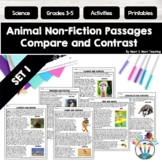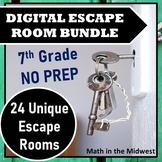39 results
7th grade chemistry simulations for Microsoft Word
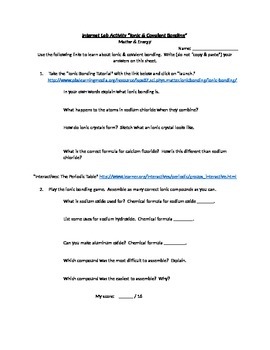
Introduction to Chemistry Internet Activity “Ionic & Covalent Bonding”
This activity/review aligns with the Common Core State Standards: STANDARD 5 - Matter and Energy"The teacher understands the nature and properties of energy in its various forms, and the processes by which energy is exchanged and/or transformed.5A. understands the atomic and nuclear structure of matter and the relationship to chemical and physical properties5C. understands the cause and effect of chemical reactions in natural and manufactured systems5F. explains conservation of mass and energy a
Subjects:
Grades:
7th - 12th
Types:
CCSS:
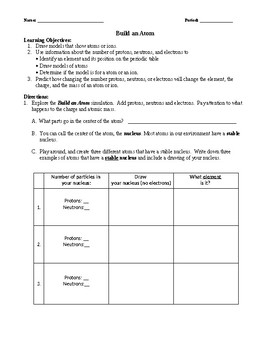
Build an Atom goes with FREE simulator at pHet-Distance Learning
After 16 years of teaching this is the BEST way I have found to teach students the basics of an atom! It is totally self directed using a very intuitive simulator. This worksheet in part is avalible for free at the pHet website but I have edited it over the last 3 years I have used it for clarity for my students and to reinforce key points. This includes a 4 page activity to go with the simulator and a 2 page follow up quiz. Also includes a answer key for all pages.
Subjects:
Grades:
6th - 9th
Types:
Also included in: Physical Science Testing Review Bundle

Lab Periodic Table Activity Simulation: Alien Element Organization
This is a comprehensive Periodic Table Lab Activity Simulation for students. There are 3 documents:
1) Lab Introduction Document with Questions and setting the context to examine unknown elements from the Planet Pumpernickel
2) 9 page flash cards of unknown alien elements that have element properties of atomic radius, electronegativity, ionization energy, conductivity, electron configuration, etc.
3) Answer Key for the most consistent element arrangement
I found this to be most successful when
Subjects:
Grades:
6th - 11th
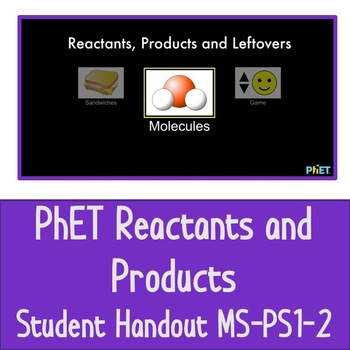
PhET Reactants and Products Student Handout, NGSS MS-PS1-2 Aligned
This is a student handout to go along with the PhET simulation Reactants and Products. This activity is geared toward middle school students, and was designed alongside the NGSS benchmark: PS1-2. For that reason, the activity gets students to the understanding that chemical reactions occur when molecules rearrange into new combinations, but it does not focus on the "leftovers." Crosscutting Concepts:PatternsScale, Quantity, and ProportionScience and Engineering Practices:Developing and Using Mod
Subjects:
Grades:
6th - 8th
Types:
NGSS:
MS-PS1-2

Mixtures and Solutions Science Experiment
For this science experiment, we explored mixtures and solutions...
For the activity, I used the following items:
-pack of dixie cups
-package of chex mix
-3 clear solo cups (+water)
-food coloring (any color)
-1 large bowl
-tissues
I gave each student a copy of the worksheet (the product you are purchasing) before we did the activity. We started first with mixtures. For this portion, I put all the chex mix in the large bowl and told the students to draw what they saw in the "after" portion o
Subjects:
Grades:
2nd - 8th
Types:
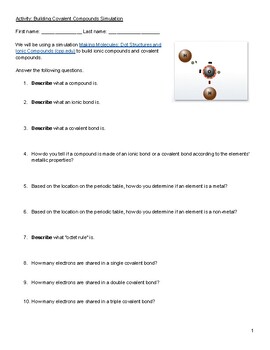
Activity: Building Covalent Compounds Simulation
This is a resource designed for Middle School and High School students. It includes Internet activities, simulations, and handouts that fit well in the subject areas of Physical Science and Chemistry.Learning Concepts:Forming covalent bonds between elements to achieve the octet ruleIdentifying the number of valence electronsIdentifying different types of covalent bondsActivities:Accessing prior knowledge about the octet rule, covalent bonds, and the difference between metals and non-metalsUsing
Subjects:
Grades:
7th - 10th
Types:
NGSS:
HS-PS1-1
, MS-PS1-1
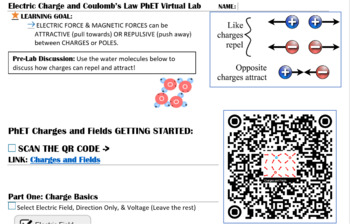
PhET Charge and Fields Virtual Lab
Virtual Lab for students covering electric charge and fields. Students gather data for relationships between charge and force, as well as distance and force. Coloumb's Law covered. Perfect for Physical Science Independent Inquiry Lesson!
Subjects:
Grades:
7th - 12th
NGSS:
HS-PS1-8
, HS-PS3-2
, HS-PS1-3

Concentration and Saturation PhET Virtual Lab
Students will learn about the concentration of solutions by working with PhET's Concentration simulation. Additional Practice worksheet included that practices skills they were to gain from the simulation.
Subjects:
Grades:
7th - 12th, Adult Education
NGSS:
HS-PS1-6
, HS-PS1-5
, HS-PS1-7
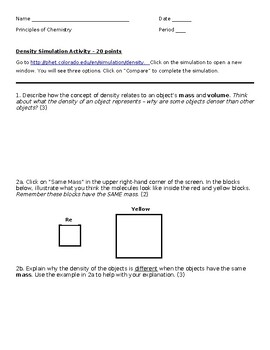
Density PhET Worksheet
PhET is a great online simulations tool for students! This worksheet helps students work independently through the PhET for DENSITY. Students draw and write about the connection between mass and volume, focusing on changing one variable at a time. The last piece is a Mystery Box for which students must solve D = m/V to determine their mystery substance.
Subjects:
Grades:
7th - 10th
Types:
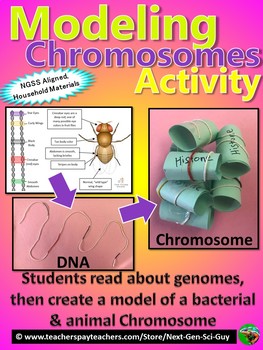
Modeling Prokaryotic and Eukaryotic Chromosomes: Distance Learning Friendly
In Brief: First, students examine prokaryotic and Eukaryotic DNA, and compare/contrast them. Next, students read some background on DNA, genomes, chromsomes, prokaryotes, and eukaryotes, and answer some questions based on the reading. Then, students create models of bacterial and fruit fly chromosomes using string, paper, markers, and tape. Finally, they answer conclusions questions about their models.A. NEXT GENERATION SCIENCE STANDARDS HEREINDCI’s: LS1.A: Structure and Function ETS1: Eng
Subjects:
Grades:
7th - 12th
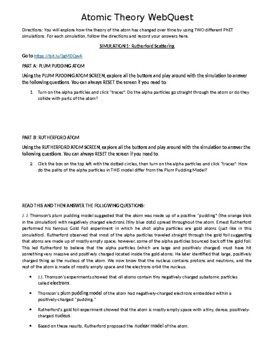
Atomic Theory WebQuest
Students will use two PhET Simulations to explore (1) how Thomson's Plum Pudding Model of the atom differs from Rutherford's Nuclear Model of the atom and (2) how Bohr Models are used to make predictions about atomic structure. Isotopes are also briefly explored. This can be used for distance learners and in-person traditional settings or hybrid-style classrooms. Can typically be completed within a 45-minute period but can be used in a 90-minute block with additional resources.
Subjects:
Grades:
7th - 12th, Higher Education, Adult Education
Types:
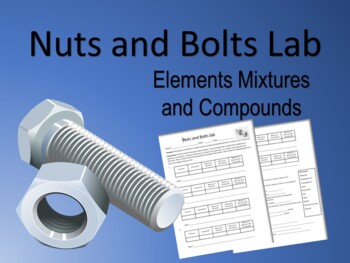
Elements, Mixtures, Compounds Lab
This lab is a GREAT way for students to visualize elements, mixtures, and compounds. Students will investigate a few numbered dishes, each that has a specific combination of nuts, bolts, and washers assembled or not assembled to represent chemical bonds. Students then investigate the contents of the dish, and determine if the dish best represents an element, mixture, compound, or mixture of compounds, or mixture of compounds and elements. The end of the activity has a great follow up with though
Subjects:
Grades:
5th - 11th
Types:

PhET Lab Build a Molecule
This is a worksheet I made to guide students through the PhET lab simulation "Build a Molecule".
Subjects:
Grades:
6th - 9th
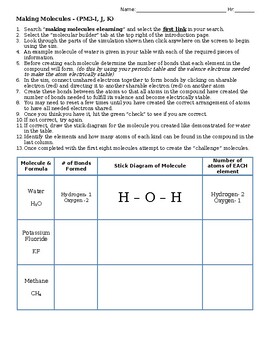
Making Molecules Dot Simulation
NGSS Expectation:MS-PS1-1: Develop models to describe the atomic composition of simple molecules and extended structures. This resources requires students to practice their knowledge of molecule building using basic bonding rules for covalent bonding where atoms share valance electrons to be able to achieve full valance layers of electrons. They bond until all atoms in the molecule/compound have satisfied this basic need/requirement. This exercise/simulation is for students to practice these ski
Subjects:
Grades:
6th - 10th
Types:

Physical or Chemical Changes Lab
In this lab activity, students will visit a series of stations, perform short lab activities, analyze the evidences of changes, and determine whether a physical or chemical change has occurred. This activity can be used as a review, an explore activity or an assessment!
This document includes the lab handout for student use, and all of the stations and instructions. The data table has space for five stations but you may include more to fit your needs. There are more than five station activ
Subjects:
Grades:
5th - 9th
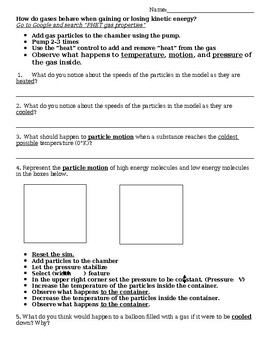
Volume and Temperature of Gases- PHET simulation
NGSS Expectation:MS-PS1-4: Develop a model that predicts and describes the changes in particle motion, temperature, and state of a pure substance when thermal energy is added or removed.This lab has students making observations of what happens to gas molecules as temperature, volume, and pressure are changed. They will observe the movement various molecules in the simulation to make connections with the previous labs they have done on temperature of fluids and how it affects their volume and den
Subjects:
Grades:
6th - 8th
Types:
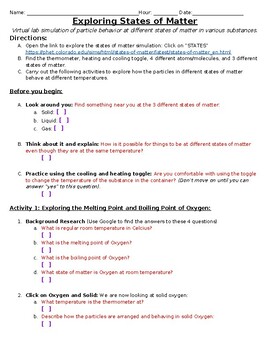
States of Matter Virtual Lab - Using PhET Lab
This is a virtual lab in which students use the PhET lab states of matter simulation to explore how particles behave in different states of matter. It also opens up the discussion of how water is different from other substances when it comes to how particles are arranged in the solid state vs the liquid state. This is great for online learners or for teachers who do not have lab resources in their classrooms but do have access to a computer lab or similar resources.
Subjects:
Grades:
7th - 10th
Types:
NGSS:
HS-PS1-5

Factors that affect the rate of reaction - Outdoor/active learning
Once you have taught the factors that affect the rate of reaction this is a fun way to embed the knowledge whilst also having a bit of fun. You could also teach it as an introduction to the topic, allowing students to learn from the demonstration as opposed to applying existing knowledge to the demo.Great opportunity to get students out of the classroom and activeEquipment required- Some outdoor space/ ask to borrow the school gym- At least 15 balls (ideally basket balls, footballs or volleyball
Subjects:
Grades:
5th - 12th
Types:
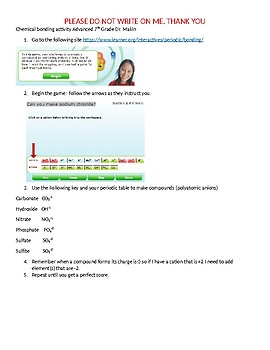
Chemical Bonding Virtual Lab
Using virtual interactive sites students for atomic bonds.
Subjects:
Grades:
7th - 11th
Types:
NGSS:
HS-PS1-1
, MS-PS1-5
, HS-PS1-2
, MS-PS1-1
Also included in: Physical Science Virtual Lab Bundle
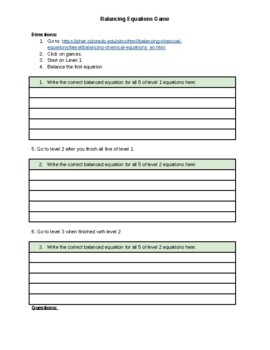
Explain Activity: Part 2 of Conservation of Matter using Phet Sim
This product follows the exploring activity of conservation of matter. Students have an introduction to balancing equations from previous Phet simulation activity. They are asked to play a game to balance equations, practicing what they have learned in the previous class, and connecting balancing equations to the Law of Conservation of Matter. Supports remote learning
Subjects:
Grades:
6th - 8th
Types:
NGSS:
MS-PS1-5

Periodic Table-Thinking Activity Challenge
In this activity, students get twenty cards of imaginary elements. They must group them two different ways according to the characteristics. Students must be able to explain how they grouped the elements and why. Students will then draw their periodic table on a sheet of copy or construction paper. In this way, students can learn how difficult (or easy) it can be to categorize the elements.
Subjects:
Grades:
6th - 10th

States of Matter Activity: Solids, Liquids, & Gases
Activity to be used after an introduction to the states of matter and the properties of the molecules in each state. Students work in groups to develop a way to visually represent molecules in each state then present to the class.
Subjects:
Grades:
6th - 9th
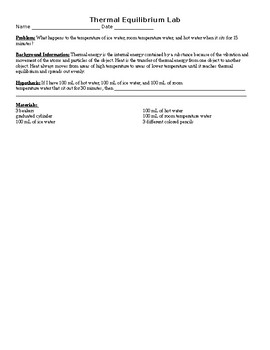
Thermal Equilibrium Lab
Thermal energy is the internal energy contained by a substance because of the vibration and movement of the atoms and particles of the object. Heat is the transfer of thermal energy from one object to another object. Heat always moves from areas of high temperature to areas of lower temperature until it reaches thermal equilibrium and spreads out evenly.
Students will test thermal equilibrium through a lab.
Subjects:
Grades:
6th - 12th, Higher Education
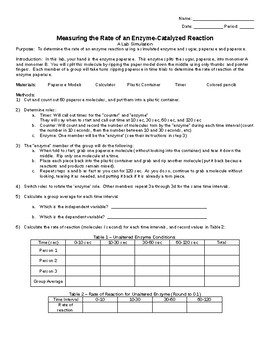
Paperase Enzyme Simulation
This is a version of a popular simulated enzyme lab. In this lab, students simulate a chemical reaction that is catalyzed by an enzyme. Then they change variables to learn how reaction rate is affected. The reaction is a hydrolysis reaction that splits a disaccharide, called paperose, into monosaccharides A and B.
Subjects:
Grades:
7th - 12th
Showing 1-24 of 39 results




